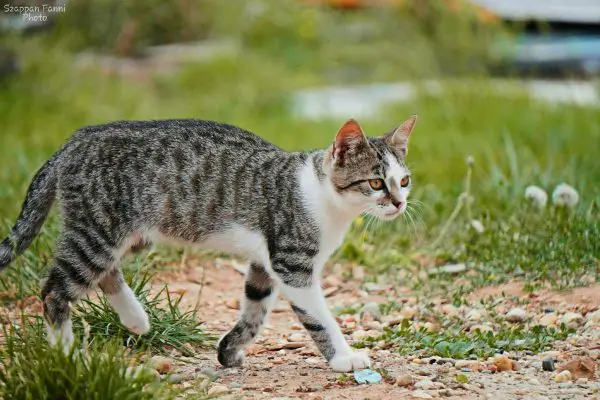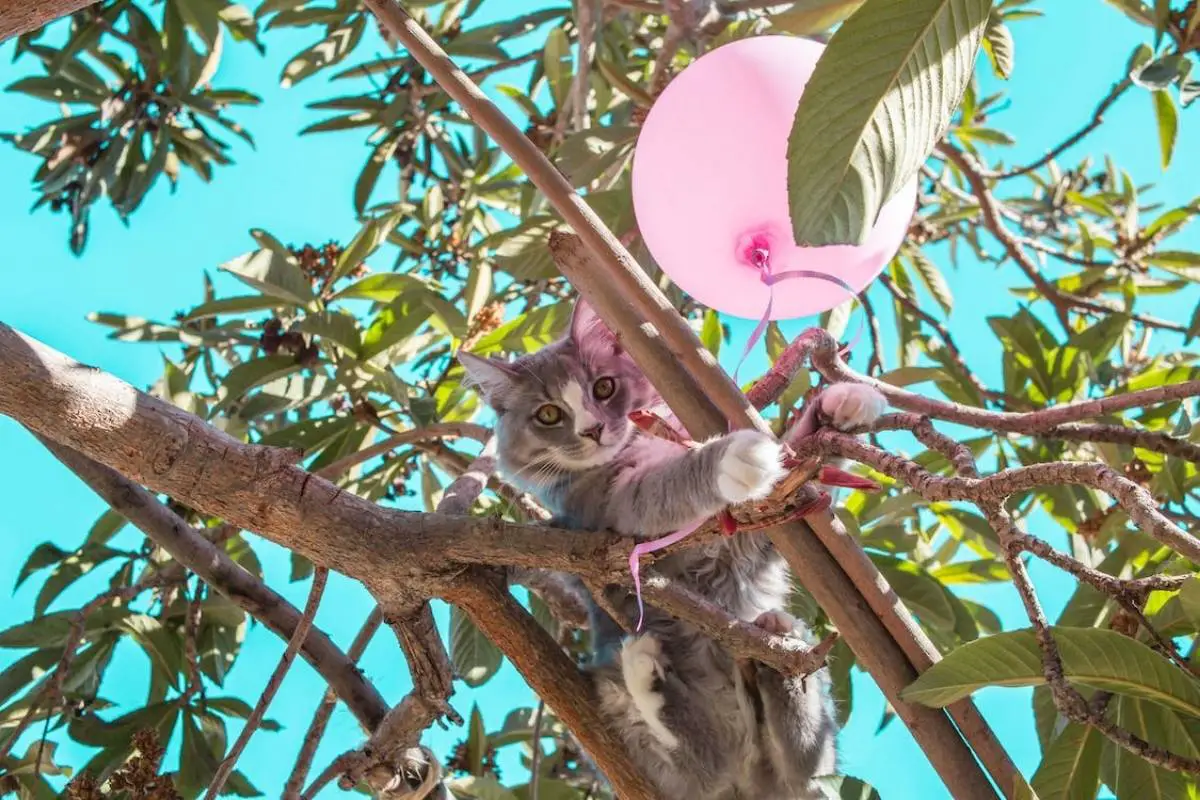We have all probably heard the phrase ‘scaredy-cat’, and it sometimes seems an apt description. You may have noticed that your cat is easily startled by things like balloons, plastic bags, or even their own reflection. It may seem odd to you that your beloved pet is so frightened of things that are so ordinary and harmless. So why is your cat so scared?
So, why is my cat afraid of balloons? The simple answer is that though cats are often considered ‘apex predators’, they are not without predators themselves, and so when they see something unfamiliar and strange in their environment, they react as if it is trying to harm them.
In this article, you will receive an in-depth explanation about why cats are so easily startled by harmless objects, come to more understanding of how your cat thinks about and perceives the world, and you will learn how to help your cat become more confident in the face of strange new things.
Why Your Cat Is Easily Surprised

You may already know what an apex predator is, but you may not have heard the term ‘mesopredator’. Where an apex predator is defined as the largest, strongest, and most effective hunter in an environment, a mesopredator, ‘meso’ meaning ‘middle’, is a predator who is both hunter and prey.
Animals like racoons and skunks fall into this category, as, though both raccoons and skunks happily eat insects and other smaller creatures, they are also vulnerable to being preyed upon themselves. Your cat can fall into this category of ‘mesopredator’.
Because your cat is a mesopredator and it can in fact fall prey to other, larger animals, your cat possesses both hunting instincts and prey instincts. Therefore, your cat is likely to see something scary or unexpected, or hear a loud noise, and react like a prey animal would by leaping away or sprinting for safety. This is at the root of why your cat is afraid of balloons.
A Dangerous World
It is likely that your cat can hold its own against another cat, but the average domestic cat is likely to lose in a fight against a large dog or a bird of prey. This unfortunate fact is something that cat owners should be aware of, particularly if you let your cat roam. Your neighborhood may seem safe, but urban-dwelling coyotes, large dogs, owls, and even foxes can hunt and kill your cat.
Though this may be news to you, your cat is fully aware that it is sometimes a target. It knows to avoid things that are potentially dangerous, even something as harmless as a party balloon. Your cat has no idea that it’s ‘just’ a balloon, and so it reacts like your birthday decorations are out on the prowl for housecats.
Understanding Flight Instincts
Your cat is likely aware of the fact that, though it has sharp claws and teeth, it is vulnerable to attack from larger animals. You may have encountered stray cats which are extremely wary and skittish of you—this is because they see that you are a large strange figure in their territory, and they don’t know what you want with them.
You may mean them no harm, but they want to keep their distance to assess you before they make any decisions about whether or not you are here to hurt them.
Most, if not all, cats possess this instinctual wariness, either because it was taught to them by their mother, learned over time, or just hardwired into them—and it’s this instinct that makes them so easily surprised and frightened by something as silly as a balloon.
Seeing Fear in Action

Understanding these facts—that your cat is instinctively afraid of new things, that it knows its vulnerability, and that it will react accordingly—are essential to being able to help your cat have a much happier life. Watching your cat leap away from a sneakily placed cucumber or plastic snake may be funny to see, but it is also an active demonstration of your cat’s instincts at work.
Imagine: your cat is distracted by something: eating food, having a drink, or watching a bird outside. When you or someone else places something strange behind it, or into its environment, you are essentially recreating, to your cat at least, a dangerous potential predator sneaking up on your cat.
When your cat sees this object, it doesn’t recognize it as nothing but a vegetable or a toy, all your cat sees is a sudden, new thing in its world, and immediately leaps away to put distance between itself and this possible danger so it can appropriately assess the new object, and then either fight or run.
Why Balloons
Similarly, a balloon may be entirely harmless: after all, it’s just some helium or air inside some plastic. However, to your cat, it is something entirely new that has somehow appeared in its territory.
Your cat has no idea what it is, and it could be a potential predator or enemy. This balloon moves strangely, it smells odd, and, if your cat is brave enough to bat at it, it pops and makes a loud, surprising noise. No wonder your cat is scared!
How to Help
With this new information, you can understand why your cat reacts so explosively to harmless objects. You may feel bad that your cat seems to have been traumatized by a harmless prank, your birthday decorations, or the mirror in your room, but there are steps you can take to make sure that your cat is much happier and less likely to be scared in the future.
– Step One: Remove What Is Frightening Your Cat. Exposure therapy, or forcing your cat to ‘face its fears’ will likely be counterproductive. It’s best to remove the object that is causing your cat distress and let your pet calm down. Otherwise, your cat’s fear may result in it hurting you or itself in its efforts to keep itself safe.
– Step Two: Make Sure Your House Is Cat Friendly. Are there lots of comings and goings in your home, or loud noises? This sort of environment can put your cat on edge and make it more likely to become frightened and bolt when faced with something unfamiliar.
Giving your cat a place where it can just be safe and happy—a quiet room where it’s bed and litterbox are located, or something similar—can make your cat feel more secure.
– Step Three: Slowly reintroduce the object. If you have to have this ‘frightening’ object in your home—something like a plastic bag, a ball, a mirror, or a balloon— you should definitely try to help your cat get used to it, but you should not do this right away. Allow your cat to return to baseline behavior. This may take quite some time, but be patient.
You want to make sure that your pet is happy and safe before you try to acclimatize your pet to this new object. Once your cat has calmed down, demonstrate that this object is not a threat. Place it in a room where you are, and make sure your cat sees that this object is not hurting you, or it.
You may have to go through these three steps more than once. This whole process will take time, patience, and lots of treats to help your cat realize that this new object is not a predator, but it’s worth it to make sure your pet is happy.
What if It Doesn’t Work?

It may be that your cat is simply too afraid to become used to this object—perhaps just because of its personality, or because of things that have happened to your cat before. In this case, it’s best to allow your cat to just be a cat, as consistent stress and fear can cause bad habits to develop.
You may want to take steps to ensure that your cat does not encounter this frightening object unnecessarily. Keeping mirrors covered when you don’t need them, trying different kinds of party decorations—these are good options for cats that are just too scared.
Of course, if you are concerned by your cat’s behavior at any time, contacting your local vet is always the best choice. There are certain medications that can help anxious cats, but those should be the last resort.
Conclusion
Though your cat may appear to be just a sweet, furry companion, in reality your pet is a predator, and still possesses many instincts that helped its undomesticated ancestors survive. The fight or flight instinct is one of the most powerful of them, and it can be easily triggered by something as simple and silly as a balloon, or their own reflection.
Coming to understand why your cat is afraid is key to helping them overcome their fear, and an important part of ensuring your cat has a safe and happy life with you.

